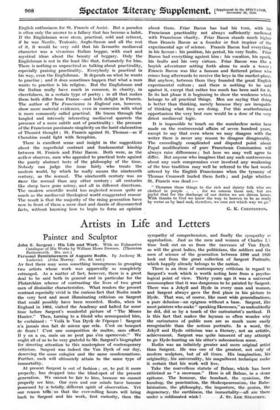Artists in Life and Letters
Painter and Sculptor
Personal Reminiscences of Auguste Rodin. By Anthony M. Ludovici. (John Murray. 10s. 6d. net.) AT first there may seem something incongruous in grouping two artists whose work was apparently so completely estranged. As a matter of fact, however, there is a great deal to be said both in general and in particular for the Plutarchian scheme of contrasting the lives of two great men of dissimilar characteristics. What renders the present contrast especially vivid is the curious fact that Rodin made the very best and most illuminating criticism on Sargent that could possibly have been recorded. Rodin, when in England in 1902, visited the Academy and halted for some time before Sargent's wonderful picture of " The Misses Hunter." Then, turning to a friend who accompanied him, he exclaimed : " Voila le Van Dyck de Pepoque ! Sargent n'a jamais rien fait de miens que cela. C'est un bouquet de fleurs ! C'est une composition de maitre, sans effort: Il y en a eu, mais on ne pert pas s'en apercevoir." We ought all of us to be very grateful to Mr. Sargent's biographer for directing attention to this masterpiece of contemporary criticism. Sargent was indeed the Van Dyck of our day, deserving the same eulogies' and the same condemnations. Further, each will ultimately attain to the same type of
immortality. .
At present Sargent is out of fashion ; or, to put it more properly, has dropped into the blind-spot of the present generation. We cannot be fair to him, beeause we cannot properly see him. Our eyes and our minds have become possessed by a.--totally different spirit of observation. Yet our reason tells. us that the ever-rolling hours will bring back to Sargent and his work, first curiosity, then the sympathy of comprehension, and finally the sympathy or approbation. Just as the men and women of Charles time look out on us from the canvases of Van Dyck, so will the great ladies, the politicians, the soldiers and the men of science of the generation between 1890 and 1920 look out from the great collection of Sargent Portraits, which happily already belongs to the nation.
There is an item of contemporary criticism in regard to Sargent's work which is worth noting here from a psycho- logical point of view. Thirty years ago it was a universal commonplace that it was dangerous to be painted by Sargent. There was a Jekyll and Hyde in every man and woman; and Sargent always gave the first place in his picture to Hyde. That was, of course, like most wide generalizations, a pure delusion—an epigram without a base. Sargent, like most painters who make " speaking likenesses," as undoubtedly he did, did so by a touch of the caricaturist's method. It is this fact that makes the layman so often wonder why the caricatures of public men are so much more easily recognizable than the serious portraits. In a word, the, Jekyll and Hyde criticism was a literary, not an artistic, achievement. Sargent was quite innocent of any attenipt to go Hyde-hunting on his sitter's subconscious sense.
Rodin was an infinitely greater and more original artist than Sargent. He was one of the greatest, not only of modern sculptors, but pf all times.. His imagination, his' originality,, his universality, his magnificent, technique make it certain that -his work will live.
• Take the marvellous statute of Balzac, which has been criticized as " a snowman." Here is all Balzac, in a stone epitome. The humour, the bombast, the cynicism, the humbug, the penetration, the Shakespeareanism, the Rabe- laisianism, the philosophy, the imposture, the genius, the degeneracy, the earthiness, -the immortality—all are there






























































 Previous page
Previous page